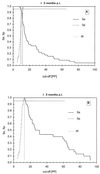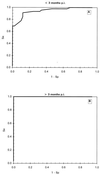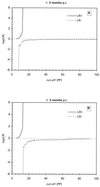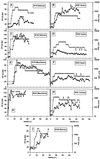Development of an indirect Tams1 enzyme-linked immunosorbent assay for diagnosis of Theileria annulata infection in cattle
- PMID: 10799453
- PMCID: PMC95886
- DOI: 10.1128/CDLI.7.3.404-411.2000
Development of an indirect Tams1 enzyme-linked immunosorbent assay for diagnosis of Theileria annulata infection in cattle
Abstract
An enzyme-linked immunosorbent assay (ELISA) was developed based on a recombinant major Theileria annulata merozoite surface antigen, Tams1. Four different recombinant proteins derived from two different Tams1 alleles, both in two different truncated forms, were tested for their performance in the ELISA. Furthermore, antigen concentration, various buffers, washing protocol, and the choice of anti-total-immunoglobulin G (IgG), anti-IgG1, or anti-IgG2 as second antibody were evaluated. The performance of the resulting ELISA was analyzed by measuring the coefficient of variation (CV). A total of 22 sera were analyzed over the measurement range, resulting in a CV of ca. 10%, whereas 30% variation is the maximum acceptable. The cutoff value was determined by the two-graph receiver operating characteristic (TG-ROC), using the indirect fluorescent antibody test (IFAT) as a reference. It was shown that up to 3 months postinfection (p.i.) IFAT is more sensitive and specific, whereas beyond 3 months p.i. ELISA performed as well as IFAT. The cutoff was determined at maximal sensitivity, based on the TG-ROC after 3 months p.i. Nine calves experimentally infected with four different T. annulata stocks remained positive in the ELISA for at least 1 year p.i. Finally, limited cross-reaction was found only with T. parva antisera, but not with any other Theileria or Babesia species. Since the T. parva endemic area hardly overlaps with T. annulata, the Tams1 ELISA has the potential to become a useful tool in the epidemiology of tropical theileriosis.
Figures







References
-
- Allred D R, Hines S A, Ahrens K P. Isolate-specific parasite antigens of the Babesia bovis-infected erythrocyte surface. Mol Biochem Parasitol. 1993;60:121–132. - PubMed
-
- Boulter N R, Brown C G D, Kirvar E, Glass E, Campbell J, Morzaria S, Nene V, Musoke A, d'Oliveira C, Gubbels M-J, Jongejan F, Hall R. Different vaccine strategies used to protect against Theileria annulata. Ann N Y Acad Sci. 1998;849:234–246. - PubMed
-
- Brocklesby D W, Barnett S F, Scott G R. Morbidity and mortality rates in East Coast fever (Theileria parva infection) and their application to drug screening procedures. Br Vet J. 1961;117:529–531.
-
- Brown C G D. Control of tropical theileriosis (Theileria annulata infection) of cattle. Parasitologia. 1990;32:23–31. - PubMed
-
- Brown C G D, Ilhan T, Kirvar E, Thomas M, Wilkie G, Leemans I, Hooshmand-Rad P. Theileria lestoquardi and T. annulata in cattle, sheep and goats. Ann N Y Acad Sci. 1998;849:44–51. - PubMed
Publication types
MeSH terms
Substances
LinkOut - more resources
Full Text Sources
Miscellaneous

